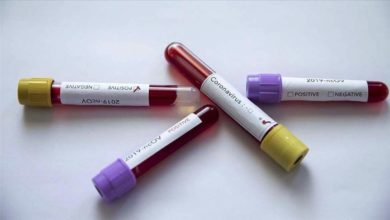The most common causes of foot cramps – and what helps
The foot suddenly becomes stiff, the toes bend and a stabbing pain shoots up the foot:

Cramps in the feet and toes are uncomfortable and bring tears to the eyes of some of those affected. Why feet and toes often cramp and what helps against the pain.
A muscle spasm is a sudden, painful, and involuntary tightening (contraction) of part or all of a muscle or group of muscles, accompanied by a palpable tightening. Most people know muscle cramps in the form of calf cramps or cramps in the feet and toes. Muscle cramps at night are particularly common. Read here what is behind it and how the cramp can be solved again.
Foot cramps: who is affected most often?
“Many young people are already affected by spasms, but the vast majority are of advanced age,” says Dr. Bernhard Dickreiter, Senior Specialist for Physical Therapy and Rehabilitative Medicine at the Joint Clinic in Gundelfingen.
About 33 to 50 percent of the elderly population over the age of 65 suffer from muscle cramps at least once a week. Muscle cramps in the calf, foot and toes that occur at night without a causal disorder are called benign idiopathic cramps.
However, cramps can also occur during or after physical activity (training-associated muscle cramps). “Athletes are very often affected, especially after very intense exertion. But muscle cramps also occur again and again after physical exertion in general if there is a disposition to cramps,” says the expert.
Cramps in the feet can indicate illness
Muscle cramps, medically called crampi, in feet and toes are painful, but mostly harmless. Rarely do foot cramps indicate illness. “In quite a few cases, the muscles are overstrained by foot deformities, such as flat feet and fallen arches. Shoes that are too tight can also promote foot cramps,” explains Dickreiter. “But since serious symptoms such as diabetes or circulatory disorders can also be behind the muscle cramps, a medical examination and clarification of the cause is advisable if the symptoms occur regularly.”
Other possible causes of muscle cramps include:
Muscle tension (due to too much or too little exercise)
joint problems
misloads
Disturbances in the mineral balance (electrolyte balance)
Dehydration (dry body) as a result of diarrhea, vomiting or heavy sweating
certain medicines, such as blood pressure medicines, diuretics (water pills), some cholesterol-lowering medicines and some antidepressants
Nerve disorders, so-called polyneuropathies
pregnancies
kidney diseases
liver diseases
hyperthyroidism
circulatory disorders
iron deficiency
Nerve damage, for example caused by diabetes mellitus (diabetes).
increasing age (favoured, among other things, by shortened muscles, lack of exercise, joint problems, incorrect loads, lack of nutrients and fluids)
Acute foot cramps – what to do?
A foot cramp often pulls those affected out of their sleep completely unexpectedly. However, unfavorable movement during sport can also cause cramps. In order to quickly relieve the stabbing pain, Dickreiter advises stretching the affected muscle: “Stretching exercises for the affected muscles have proven their worth. For example, while sitting, pull your cramped toes towards your body with one hand and/or stimulate the muscles with stroking massages toes and feet the lymphatic and venous drainage.” Careful walking can often relieve the acute spasm in the foot and toes.
Walking barefoot strengthens your feet
According to the expert, walking barefoot is generally recommended to prevent cramps in the feet. It strengthens both the foot muscles and the arch of the foot. It also promotes a healthy toe position and can thus correct or prevent damage such as flat feet and splayfoot. Warm alkaline foot baths and alkaline wraps that stimulate circulation also have a relaxing effect on the muscles. If necessary, the intake of magnesium is also helpful.
Can Magnesium Relieve Cramps in Foot and Toes?
The current guidelines recommend taking magnesium. However, the authors point out that the effectiveness has not been sufficiently proven. However, according to the guideline, a therapy attempt with magnesium should be undertaken in any case due to the favorable side effect profile, since magnesium stabilizes the muscle membrane and reduces action potentials that trigger contractions in the muscle. Magnesium may also be effective during pregnancy.
Even if the effect of magnesium has not yet been scientifically proven, patients repeatedly report that magnesium reduces their frequency of cramps. Although quinine has been proven to be effective as a drug, according to the neurologists it should only be used as a secondary measure and only if the cramps are severe because of the (rare) serious side effects, including possible blood clotting disorders.
Preventing foot cramps: Here’s what you can do
If you want to prevent cramps in your feet and toes, you can try the following tips:
Eat a balanced, wholesome diet. In this way you supply your body with important minerals, vitamins and trace elements that the muscles need.
Eat magnesium-rich foods regularly, such as bananas, nuts and whole grain products.
Make sure you get enough protein. The reference values of the German Society for Nutrition (DGE) are 0.8 grams per kilogram of body weight per day.
Drink enough. The DGE advises healthy adults to drink 1.5 liters a day. Mineral water supports the daily intake of minerals. People with heart or kidney disease should discuss the individual amount they drink with their doctor.
Coffee can have a dehydrating effect and may therefore promote cramps. If the cramps recur, drink a little less coffee and see if the cramps subside.
Drink alcohol in moderation. Alcohol has a negative effect on the electrolyte balance and the way the nerves process stimuli.
Give up cigarettes. The toxins contained in tobacco disrupt blood circulation, among other things.
Keep moving. Muscles need training – also for a good supply of nutrients.
Warm up well before exercise and do gentle stretching before and after exercise.
If you suspect a nutrient deficiency, have your doctor do a blood test. Take supplements such as magnesium, calcium and potassium only as directed.
Medications, such as certain antihypertensives, cholesterol-lowering drugs or diuretics, often promote cramps. Talk to your doctor if you suspect it. Always have recurring cramps in your legs and feet checked out by a doctor.



